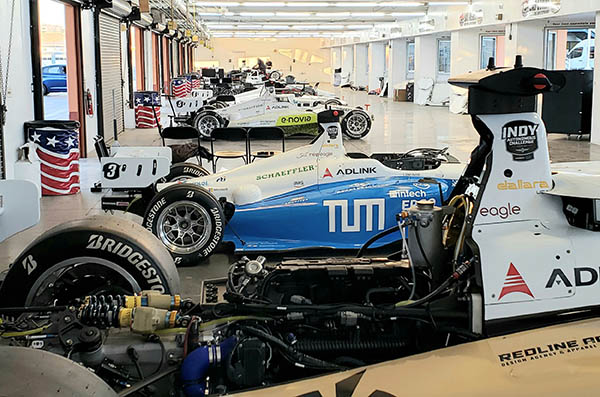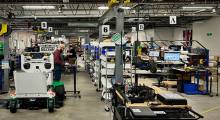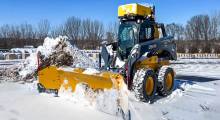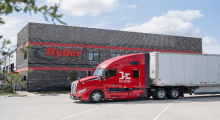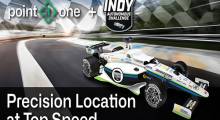On of the more exciting events around the international Consumer Electronics Show in Las Vegas this week is the Autonomous Challenge @ CES. It was organized by Energy Systems Network, which also conducted the Indy Autonomous Challenge in October 2021. The goal of the self-driving race, which features university teams and technology and automotive sponsors, is to advance the state of autonomous vehicles.
Paul Mitchell, CEO of Energy Systems Network (ESN) and head organizer of the Indy Autonomous Challenge (IAC), discussed preparations for the Autonomous Challenge @ CES with Robotics 24/7.
How did your background in public affairs lead you to big technology events?
Mitchell: My journey has always been about intersection of government, industry, and technology innovation. How can governments, corporations, and universities partner to innovate and attract talent?
At ESN, our work over past decade has been to organize and manage projects and public-private partnerships. Our funding has been a mix of government and philanthropic, with teams from leading research universities. Sponsors include big companies like Cisco and Luminar. Public policy is a helpful background.
How is today's race different from October's race at the Indianapolis Motor Speedway (IMS)?
Mitchell: Teams must still be able to demonstrate their capabilities, but it's a smaller in-person crowd. It's open to CES attendees but scaled back due to COVID-19.
Going back to the IMS, we showcased where the 19 teams were in their journey toward eventual head-to-head racing. Based on a variety of conditions, like weather, we didn't feel that putting multiple cars on track was a safe bet at that time.
We wanted to first show that autonomous cars could go fast in a safe but exciting environment, so we had a time-trial format.
We did include things like pylons for obstacle avoidance. It was important to ensure that teams couldn't just program vehicles to stay on a standard race line. They also had to use perception systems including lidar, radar, and optical sensors.
The teams did pass one another in tests before October, and when we completed that event, our organizers and the teams got together and discussed that they had more to show.
How did ESN choose CES for the next competition?
Mitchell: We've had a great partnership with the CTA [Consumer Technology Association, the organizer of CES]. We first rolled our base car at the virtual CES 2021. We have the same teams and cars as at the IAC, and it was a logical progression to do that at CES 2022.
What do you expect of the teams in the Autonomous Challenge @ CES?
Mitchell: The competition this time will likely include some time trials to set the grid and determine pairings for the passing competition. It's a new format, with self-driving race cars going at same time at increasingly higher speeds. Eventually one car won't be able to pass.
All nine teams that participated in October are here and have people on the ground. Everyone is seeking to participate, but there's no guarantee that everyone will be on the track.
Another difference is that the $1 million grand prize that the Technical University of Munich won is now over. It's a more modest amount now.
How have the teams been getting ready?
Mitchell: This week, the teams have been practicing to demonstrate for themselves and the organizers before the live broadcast. They're in it for the long run, and other events are possible.
In general, the teams involved have opted to focus on collaboration over competition, but they're all excellent competitors.
We're putting on a show to advance the state of the art. As we move into passing competition, we need multiple teams that are close to the same level to be successful.
While the teams use common hardware and ROS-based software, what are some of the technical challenges this time?
Mitchell: Can we demonstrate multicar high-speed automation?
Another challenge we're facing is wear and tear from stress of practicing. Every car has wrecked at least once. The cars themselves become bit of a liability. The hardware gone through a lot, including transport from Indianapolis to Las Vegas. We're starting to see some stress-test carnage. It's tough, because the teams want to compete on their unique algorithms.
But as with any racing series—like Formula 1, where there's a series winner for the driver and the manufacturer—running cars is a challenge.
IAC is not just about software driver; it's also about a very significant systems integration challenge. Teams are a bit nervous about keeping everything going at speeds of 150 to 160 mph [241.4 to 257.4 kph]. The central computer could crash, or a chip could stop functioning.
Have the teams continued working on their autonomy software?
Mitchell: First, there's a lot of base software, including different drivers, that is different from their algorithms. When make adjustments to low-level software, the teams can contribute to that. One team may come up with a workaround that's then shared and implemented by everyone.
We have three different technical challenges. No. 1 includes hardware integration and operation, and No. 2 is the base software that allows hardware to communicate and operate efficiently.
No. 3 are the autonomous algorithms that the teams develop. They don't share the brains for the robotic drivers, and the rest of the vehicle is the body.
They're adjusting algorithms every single day. As the teams get information from the Las Vegas Motor Speedway and make adjustments, they'll dial it in and stop making changes on Wednesday for Friday.
How have partners and sponsors helped ESN and the competitors?
Mitchell: Three different categories make this whole thing possible. First are the organizers. ESN is the one that has to make the decision whether to run an event, can change the rules, determine whether a team can participate, and adjust the vehicles.
Other founding partners include the Indiana Economic Development Corp. The state put in seed funding, as it viewed the intersection of motor sport and automation as classically Hoosier. Indianapolis claims to be the motor sport capital of the world, and Indiana is one of the top states for automotive manufacturing and engineering in the U.S.
The IMS was the third founding partner and has been a test bed for validation of early internal combustion engine vehicles, which led to the Indy 500.
Then there are the industry sponsors—organizations willing to provide the hardware, some base software, engineering support, and funding to allow vehicles to be designed, engineered, and built. They include Dallara and Clemson University, which is not a competitor but contributed to design and engineering.
We then worked with suppliers such as Luminar for lidar, Aptiv for radar, Schaeffler for drive by wire, and Cisco for networking and vehicle-to-vehicle communications. IAC also worked with New Eagle for software and ADLINK for hardware. They're known players in the autonomous vehicle industry and saw the race as a good testbed for infrastructure.
How did you choose component technology providers?
Mitchell: We chose one OEM, but not using its full stack. We chose components to have diverse partners and sponsors.
For example, Luminar is a poster child for how the IAC can harmonize perfectly with a company bringing new technology to market. In our use case, lidar is the most essential component, especially as we move into the passing challenge.
Luminar was a brand-new company that was not public yet. Its solid-state lidar technology had lots of prototyeps, but was not yet in production when we started. But it was unique in that it could be packaged and put into the form factor of a racecar.
Now, Luminar has grown exponentially in the time of our partnership, and its tech is front and center in our vehicles. I belive that IAC has been good way to test and validate technology and give it some visibility in a way generally reserved for an OEM like GM or Tesla.
Speaking of commercialization, how much is the race toward more autonomous vehicles affecting the IAC?
Mitchell: There's a lot from our competition feeding back into the autonomous race. Most of the components in our race cars have had some type of stepwise improvements made by our teams and transferred to sponsor companies.
They've led to everything from firmware updates used in products worldwide to changes in their base software settings and parameters. For instance, we didn't know before that some subsystem would shut down under certain conditions. That means that we're stress-testing components in way that suppliers are getting the benefits validation to implement in their products going forward.
We announced this week that TUM Autonomous Motorsport, the winning team from TU Munich, has launched the IAC's first spinoff—driveblocks. It is providing software and services for SAE Level 4 and Level 5 automation.
A mix of advances will support individual component and supplier companies, and we expect team to spin out companies like the DARPA Grand Challenge did.
About the Author
Follow Robotics 24/7 on Linkedin
Article topics
Email Sign Up

